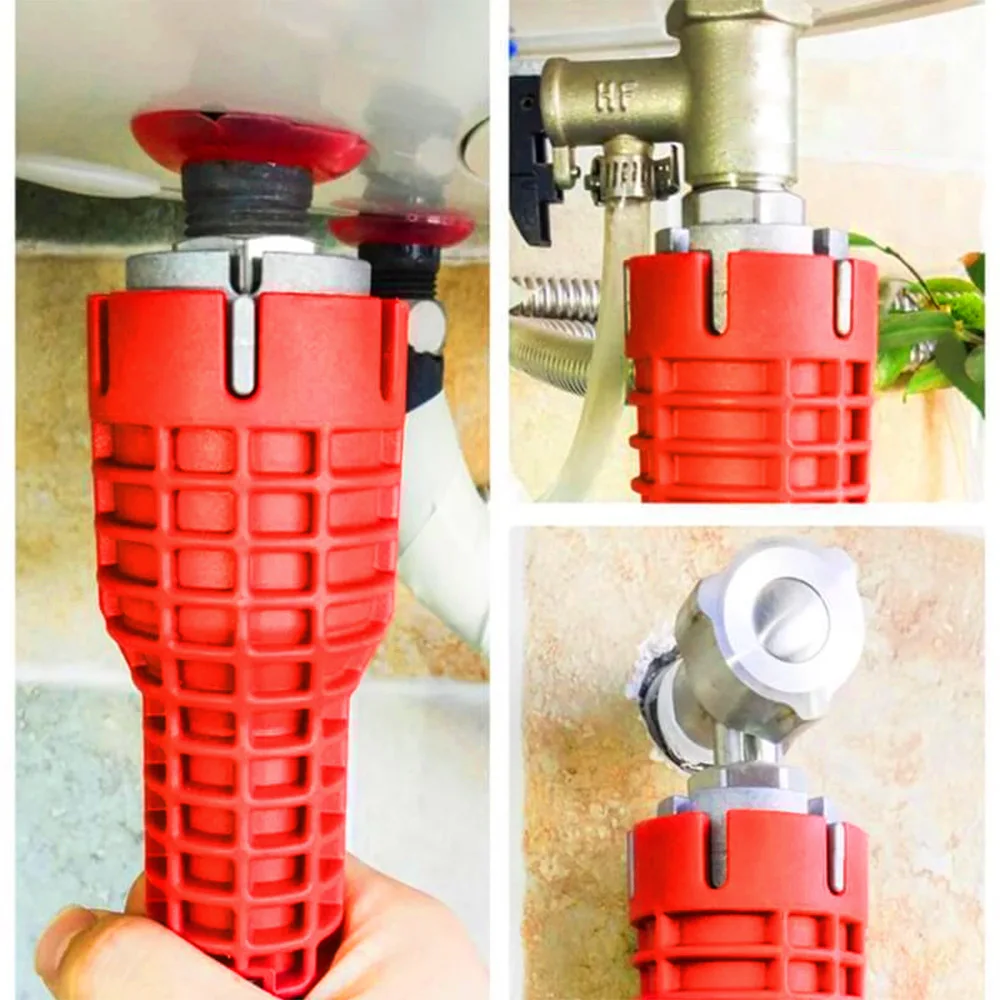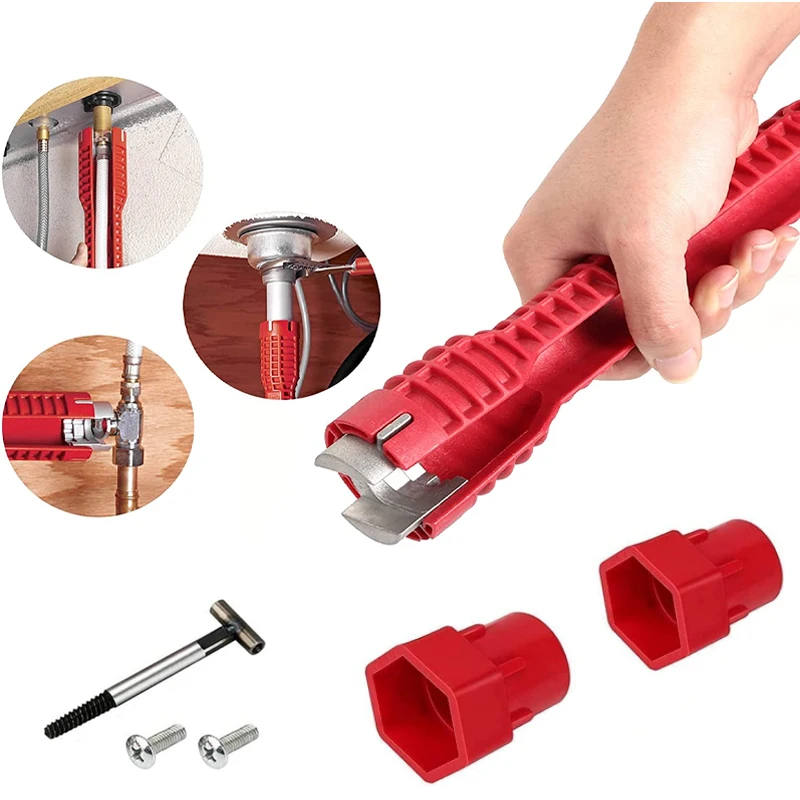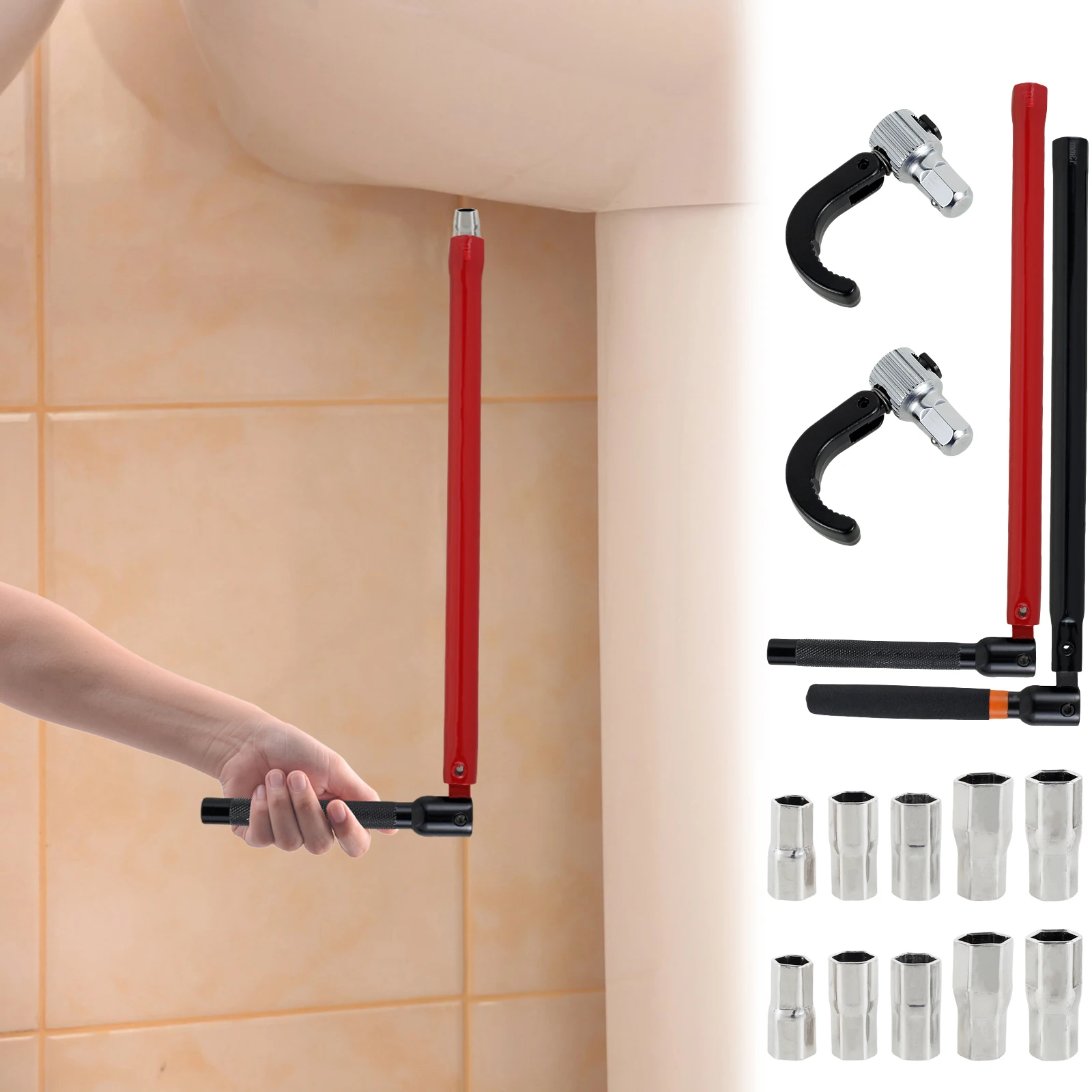
Top Features to Look for in a Durable and Effective Sink Wrench
When it comes to fixing leaks or replacing faucets under the sink, space is always tight. That’s where a sink wrench becomes an indispensable tool for both DIYers and professional plumbers. Designed specifically for cramped areas beneath sinks, this compact yet powerful tool allows you to reach and tighten nuts that standard wrenches can’t access. Without a sink wrench, many plumbing jobs become frustrating, time-consuming, or even impossible.
Moreover, a sink wrench features a long handle and adjustable jaw. This design provides leverage and flexibility in confined spaces. Whether you’re working on kitchen sinks, bathroom vanities, or utility basins, this tool makes the job faster and safer. It reduces the risk of damaging pipes or injuring your hands from awkward angles.
Additionally, modern sink wrench models come in various styles. Some are fixed, while others offer swivel heads or telescoping handles. These innovations improve grip, control, and efficiency. As more homeowners take on home improvement projects, demand for reliable tools like the sink wrench continues to grow.
In this article, we’ll explore the different types of sink wrench, how to use them properly, top brands, maintenance tips, and why they’re a must-have in any toolkit.
 What is a Plumbing Wrench?
What is a Plumbing Wrench?
A sink wrench, also known as a basin wrench, is a specialized plumbing tool. It is designed to tighten or loosen nuts and bolts in hard-to-reach areas, especially beneath sinks. This tool is essential for tasks where traditional wrenches are ineffective due to limited space. Its elongated handle and pivoting jaw make it highly effective in narrow, awkward spaces.
Description and Purpose
The sink wrench has a long shaft, typically adjustable, with a spring-loaded jaw at one end. The jaw pivots to grip nuts and bolts securely. Plumbers use this tool to reach areas under or behind sinks, such as for faucet installation or removal. Its purpose is to simplify plumbing tasks and reduce strain when working in tight spaces.
Types of Sink Wrenches
There are two main types of sink wrenches:
- Adjustable Sink Wrench: Comes with a telescoping handle, offering flexibility in various spaces. It is suitable for most plumbing tasks.
- Fixed Sink Wrench: Has a fixed-length handle and jaw angle, ideal for specific tasks without adjustment needs.
Both types are made from durable materials like steel, ensuring longevity. Some sink wrenches also have cushioned handles for better grip and comfort during extended use.
Understanding these types helps you choose the right tool for your plumbing needs. A good sink wrench saves time and makes repairs easier.
When to Use a Plumbing Wrench
A sink wrench is an essential tool for specific plumbing tasks. Its design allows it to work in tight spaces where regular wrenches fail. Knowing when to use a sink wrench can save time and prevent frustration.
Common Plumbing Problems it Solves
- Faucet Replacement: Removing or installing faucets often involves hard-to-reach nuts beneath sinks.
- Leaky Connections: Tightening loose nuts in confined spaces, such as under basins or near wall fixtures.
- Drain Repairs: Accessing and loosening drain pipe connections, especially in cramped areas.
- Installing Water Lines: Connecting water supply lines securely, which often requires precise work in awkward spots.
These problems are common in household plumbing, and a sink wrench makes fixing them easier. By using the tool correctly, you can quickly solve plumbing issues without damaging surrounding parts.
Situations Requiring a Sink Wrench
- Tight Spaces: When nuts and bolts are in narrow or obstructed areas under sinks.
- Limited Tool Access: When standard tools like pliers or crescent wrenches cannot reach tight locations.
- Complex Assemblies: During tasks that involve multiple connections requiring specific adjustments.
- Professional Repairs: Plumbers often rely on sink wrenches for precision tasks during installations and repairs.
Identifying these situations ensures you choose the right tool for effective plumbing work. Keep a sink wrench in your toolkit for challenging tasks you might face.
 Step-by-Step Guide to Using a Plumbing Wrench
Step-by-Step Guide to Using a Plumbing Wrench
Using a sink wrench effectively involves proper preparation, positioning, and technique. Follow this guide to simplify your plumbing tasks.
Preparing for the Task
- Assess the Problem: Identify the nut or bolt requiring adjustment.
- Gather Tools: Ensure you have all necessary tools, including the sink wrench.
- Clean the Workspace: Remove debris and obstacles beneath the sink.
- Protect Yourself: Wear gloves and safety goggles to prevent injuries while working.
- Turn Off Water Supply: Shut off the main water valve to avoid leaks.
Proper preparation ensures smooth and safe execution of your task.
Proper Positioning and Grip
- Position the Sink Wrench: Slide the wrench jaw over the nut or bolt carefully.
- Adjust Jaw Angle: Lock the pivoting jaw to grip the nut securely.
- Hold the Handle Firmly: Use a strong grip for better control and stability.
- Align the Tool: Ensure the shaft remains straight to prevent slipping.
Correct positioning improves efficiency and reduces the chance of damage.
How to Use it to Tighten or Loosen Nuts
- Apply Pressure: Pull the handle to tighten or push to loosen the nut.
- Avoid Over-tightening: Use gradual pressure to preserve the threads.
- Test Connections: Ensure proper adjustment by checking the tightness of the nut.
- Repeat as Needed: If a connection feels loose, reposition the wrench and try again.
Using a sink wrench carefully can save time and prevent costly issues while working in tight spaces.
Tips for Working with a Plumbing Wrench
Using a sink wrench efficiently requires proper techniques and understanding of best practices. Follow these tips to enhance your plumbing efforts and avoid unnecessary challenges.
Safety Precautions
- Wear Protective Gear: Use gloves to protect your hands and goggles to shield your eyes.
- Turn Off Water Supply: Always shut off the water to prevent accidental leaks.
- Check Workspace Stability: Ensure the area under the sink is stable and free from hazards.
- Use the Right Tool Size: Choose a sink wrench that fits the nut or bolt securely to avoid slipping.
- Avoid Overextension: Do not stretch too much; reposition yourself to work comfortably.
- Inspect the Wrench: Regularly check for wear or damage to avoid accidents during use.
Maximizing Efficiency
- Plan Ahead: Assess the task and gather all necessary tools before you begin.
- Use Adequate Lighting: Work in a well-lit area to see connections clearly.
- Position the Wrench Strategically: Place the wrench jaw at the optimal angle for the task.
- Practice Control: Grip the handle firmly but avoid excessive force to maintain control.
- Apply Even Pressure: Tighten or loosen nuts gradually to avoid damaging threads or fittings.
- Keep Workspace Organized: Clear debris or tools that might obstruct your movement.
Avoiding Common Mistakes
- Skipping Preparation: Not assessing the workspace properly can lead to inefficient work.
- Using Excess Force: Over-tightening nuts can strip threads or damage plumbing connections.
- Wrong Tool Selection: Using the incorrect type of wrench can make the task more difficult.
- Ignoring Ergonomics: Bad posture or improper grips can cause strain or poor results.
- Forgetting to Double-Check: Always ensure the connection is secure before completing the task.
- Neglecting Safety Gear: Skipping gloves or goggles can result in unnecessary injuries.
By following these tips, you can use a sink wrench effectively, safely, and efficiently. Proper preparation and technique make plumbing tasks easier and less stressful.
 Alternative Tools to Plumbing Wrench
Alternative Tools to Plumbing Wrench
Sometimes, a sink wrench may not be the ideal tool for a plumbing task. In such cases, alternative tools can provide better efficiency and results. Understanding these options helps you choose the right tool for specific tasks.
Comparing Sink Wrenches to Other Plumbing Tools
- Adjustable Wrenches: Adjustable wrenches work well for loosening or tightening easily accessible nuts and bolts. They cannot reach as deeply or pivot like sink wrenches, making them less suitable for tight spaces beneath sinks.
- Pipe Wrenches: Pipe wrenches are designed for gripping and turning larger pipes and fittings. They are best for heavy-duty work but lack the finesse required for compact areas where sink wrenches excel.
- Pliers: Standard or slip-joint pliers can handle a variety of general plumbing tasks. Their short handles and limited reach make them impractical for hard-to-access nuts or bolts below basins.
- Socket Wrenches: These tools are excellent for efficiently loosening or tightening nuts of specific sizes. However, their rigid structure is ill-suited to tight or awkward spaces.
- Universal Multi-Grip Tools: These can adapt to various sizes and shapes of fasteners. They are versatile but may not provide the same secure grip as a sink wrench in specialized situations.
By comparing these tools, you can see the unique advantages a sink wrench offers for confined spaces. However, alternatives may be more effective for tasks outside a sink wrench’s scope.
When to Choose Another Tool Over a Sink Wrench
- Easily Accessible Nuts: For nuts that are exposed and easy to reach, an adjustable wrench may suffice.
- Heavier-Duty Work: Use a pipe wrench for handling large pipes and fittings that need extra force.
- Precise Tasks: A socket wrench may be better for tasks requiring exact tightness levels, as they offer great accuracy.
- Versatile Needs: If working on various fasteners, a universal multi-grip tool can save time.
- Simpler Repairs: For quick fixes on surface-level nuts and bolts, pliers are often enough.
While a sink wrench is invaluable for tight and awkward spaces, its specialized design means it’s not always the best choice. Evaluate your task requirements to pick the most effective tool for the job.
Maintenance and Care for Your Plumbing Wrench
Proper maintenance of your sink wrench ensures it works efficiently and lasts longer. Regular cleaning and careful storage can prevent damage. Adopting good care practices will save you time and money in the long run.
Cleaning and Storage
- Clean After Each Use: Wipe the wrench with a damp cloth to remove dirt and grease.
- Use Mild Soap: For stubborn grime, use mild soap and water to clean the tool.
- Dry Thoroughly: Always dry the sink wrench completely to prevent rust.
- Lubricate Moving Parts: Apply light oil on the pivoting jaw to ensure smooth movement.
- Store in a Dry Place: Keep the tool in a moisture-free area to avoid corrosion.
- Use Toolboxes or Mounts: Store your wrench in a toolbox or hang it securely to avoid misplacing it.
Ensuring Longevity
- Inspect Regularly: Check for wear or damage to prevent accidents during use.
- Avoid Dropping the Tool: Handle with care to prevent misalignment or cracks.
- Tighten Loose Components: Keep all parts securely fastened to maintain proper functioning.
- Choose Quality Wrenches: Invest in high-quality tools to reduce the risk of premature wear.
- Don’t Overuse: Avoid using excessive force that could damage the jaws or handle.
- Follow Manufacturer’s Instructions: Use the wrench as intended to avoid unnecessary wear.
By cleaning, inspecting, and storing your sink wrench properly, you can ensure it stays in good condition for years. Frequent checks and small steps in care make a big difference in its usability.
 Purchasing the Right Plumbing Wrench
Purchasing the Right Plumbing Wrench
Choosing the right sink wrench ensures effective and hassle-free plumbing work. Consider several factors to make a wise purchase.
Key Features to Look For
- Adjustable Jaw: Opt for a wrench with an adjustable jaw for versatile nut and bolt sizes.
- Handle Length: Select a length suitable for your workspace. Long handles provide better reach.
- Build Material: Choose durable materials like steel for longevity and resistance to wear.
- Pivoting Jaw: Ensure the jaw has a good pivot range to access hard-to-reach spots.
- Non-Slip Grip: A cushioned or textured handle improves grip and reduces hand strain.
- Weight: Pick a lightweight wrench to avoid fatigue during extended use.
- Size Compatibility: Ensure the wrench fits the most common nut sizes in your plumbing fixtures.
By focusing on these features, you can find a sink wrench that suits your needs perfectly.
Recommended Brands and Types
- RIDGID Basin Wrenches: Known for their durable construction and precise functionality.
- TEKTON Adjustable Wrenches: Excellent for versatility and cost-effectiveness.
- General Tools Adjustable Basin Wrenches: Provide a compact design, ideal for tight spaces.
- Husky 10-Inch Adjustable Basin Wrenches: Popular for their telescoping handles and secure grip.
- Superior Tool Basin Buddy: A unique design suitable for DIY enthusiasts and professionals alike.
Different brands and types cater to varied plumbing needs. Choose one based on your specific tasks and budget. With the right sink wrench, plumbing projects become significantly easier and more efficient.
Frequently Asked Questions About Plumbing Wrench Tools
Can I use a regular wrench instead of a sink wrench?
Sometimes, but only if there’s enough space. Most under-sink areas are too tight for standard tools.
Do I need a special wrench for Moen or Delta faucets?
No, most sink wrench models fit standard faucet nuts. Universal jaws handle common sizes.
Is a ratcheting sink wrench worth the extra cost?
Yes, especially for frequent use. It reduces motion and speeds up the job.
How do I clean a rusty sink wrench?
Scrub with steel wool and vinegar. Dry thoroughly. Apply oil to prevent future rust.
Can a sink wrench be used on toilets?
Rarely. Toilet bolts are usually accessed with a socket wrench. The sink wrench is designed for faucet mounts.
Are there cordless electric versions?
Not commonly. Most are manual. However, some powered tools mimic the function for industrial use.
What size sink wrench do I need?
Most jobs require 12–16 inches. Measure your cabinet depth before buying.
Can women use a sink wrench easily?
Yes, the long handle provides leverage. It reduces the strength needed to loosen tight nuts.
 Final Thoughts: Why Every Homeowner Should Own a Plumbing Wrench
Final Thoughts: Why Every Homeowner Should Own a Plumbing Wrench
Plumbing issues don’t wait for professional help. Having the right tools gives you the power to act fast. A sink wrench is one of the most useful yet underrated tools in home maintenance.
Moreover, it solves a common problem: inaccessible hardware under sinks. Without it, simple repairs turn into messy, drawn-out projects. With it, you gain confidence and efficiency.
Whether you’re changing a faucet, fixing a leak, or upgrading fixtures, the sink wrench makes the job manageable. Its design proves that smart engineering beats brute force.
In conclusion, no toolbox is complete without a sink wrench. It’s affordable, durable, and essential for modern plumbing tasks. Keep one handy—and never struggle under the sink again.

